HISTORY
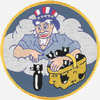
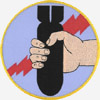
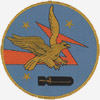
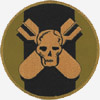
The 379th Bomb Group was activated November 26, 1942, at
Gowen Field, Boise, Idaho. It consisted of four
squadrons of B-17s, the 524th, 525th, 526th and 527th.
Overseas movement began in April, and in May the 379th
arrived at Kimbolton, England, AAF Station 117. Its
first combat mission was the bombing of German U-boat
pens at St Nazaire, France, on May 29, 1943. Colonel
Maurice A. Preston was the original commanding officer
until October 10, 1944, when he became the commander of
the 41st Combat Wing headquartered at Molesworth.
Colonel Lewis E. Lyle then assumed command of the 379th
Bomb Group until May 5, 1945, when he became commander
of the 41st Combat Wing. Lt. Col. Lloyd C. Mason was
then named commander of the 379th Bomb Group, and was
followed by Lt. Col. Horace E. Frink.
Like many B-17 bases in England, the airfield at
Kimbolton was originally a fighter base for the British.
When it became evident Germany was not going to invade
England, the RAF decided it didn't need many inland
fighter bases and was happy to lease most of them to the
United States as airfields for heavy bombers. The
runways and perimeter ramps were too thin to accommodate
the weight of our Flying Fortresses and Liberators, so
the United States paid the British to repair and replace
the runways to meet necessary specifications.
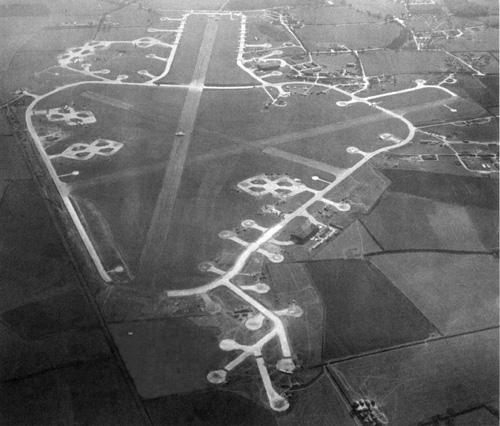
Click on the photo to enlarge picture and see planes
taking off
The attached photo of the airfield as it was submitted by one of our associate members, Mark Ellis of Los Angeles. Some of the only remaining structures from years ago can be seen in the cluster of buildings in the low-center-right of the picture, not far from the road where the memorial to the 379th is located.
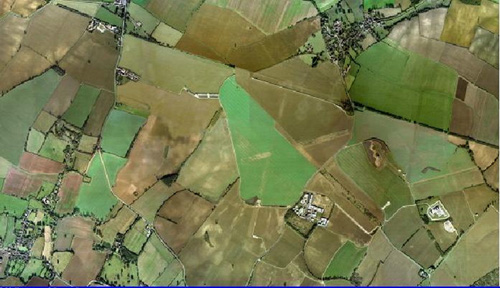 Click on the
photo to enlarge the colored picture.
Click on the
photo to enlarge the colored picture.
The 379th Bomb Group was one of 12 heavy Bombardment Groups in the First Bombardment Division of the United States 8th Air Force. All B-17s of every Group within the 1st Bombardment Division had a large triangle painted at the top of the vertical stabilizer. Each Group's assigned code letter was painted in the triangle. The 379th's planes were assigned the letter K, and were known as the Triangle K Group.
The 379th Bomb Group flew its first 300 missions in less time than any other heavy Bombardment Group. During all of its 330 bombing missions, it dropped 26,640 tons of bombs on enemy targets, shot down 315 enemy aircraft and lost 141 of its B-17s to enemy action.
Eighty of those 141 Fortresses were shot down between May 29, 1943, and March 31, 1944. The other 61 Fortresses were lost between April 1, 1944, and April 25, 1945. One record lists 345 Fortresses assigned to the 379th Bomb Group during World War II. It is very startling that more than 43% of those 345 Fortresses were lost to enemy fighters and anti-aircraft guns.
Information in the 8th Air Force News indicates the 379th Bomb Group lost one B-17 to enemy action for every 70 sorties flown, for a loss rate of one bomber for every 22 missions. This compares to 1 bomber lost per 30 sorties by the Group with most bad fortune, and 1 bomber lost per 230 sorties for the Group with the least bad fortune. The average loss rate for the 40 Bomb Groups was 1 bomber per 88 sorties.
The 379th led the 8th Air Force in bombing accuracy, flew more sorties than any other heavy Bomb Group and had a lower loss and abortive ratio than any unit in the 8th Air Force for an extended period of time. Some of its other accomplishments include: development of the 12-plane squadron formation and 36-plane integral Group, and use of a straight-line approach on the entire bomb run.
In May 1944 it was announced that the 379th had made an unprecedented "8th Air Force Operational Grand Slam" during the preceding month. This meant that during April the 379th was first in every phase of bombing in which Bomb Groups of the 8th Air Force were graded. The 379th Bomb Group was the only unit ever awarded the 8th Air Force Grand Slam, a very unique honor that included recognition of the following achievements:
1 - Best Bombing results (greatest percent of bombs on target)
2 - Greatest tonnage of bombs dropped on target
3 - Largest number of aircraft attacking
4 - Lowest losses of aircraft
5 - Lowest abortive rate of aircraft dispatched.
The 379th received two Presidential Unit Citations for its accomplishments in combat. The Group flew its last combat mission on April 25, 1945. The 379th Bomb Group remained active for two years, seven months and 29 days. During this period approximately 6,000 personnel were assigned to the Kimbolton airfield. The Group was deactivated on July 25, 1945, at Casablanca, Morocco, Africa.
(Data about the 379th Bomb Group is from "Screwball Express" and is printed here with the permission of Ken Cassens,
author of the book, with all rights reserved)
SQUADRONS OF THE 379th BG (H):
524th Bombardment Squadron
525th Bombardment Squadron
526th Bombardment Squadron
527th Bombardment Squadron
Assigned 8th AAF: April 1943 - Wing/Command Assignment:
8th AF, 1st Bomb Division, 103 PCBW: May 1943
8th AF, 1st Bomb Division, 41st Combat Wing: 13 Sept.1943
1st Bomb Division, 41st Combat Wing: 8 Jan 1944
1st Air Division, 41st Combat Wing: 1 Jan 1945
Combat Aircraft:
B-17F
B-17G
Group COs: Col. Maurice A. Preston 26 November 1942 to October 1944
Col. Lewis E. Lyle 11 October 1944 to 5 May 1945
First Mission: 29 May 1943, St. Nazaire, France
Last Mission: 25 April 1945, Pilsen, Czechoslovakia
Total Sorties: 10,492
Total Bomb Tonnage: 26,460
Tons Aircraft MIA: 149
Stations:
Kimbolton 20May43 To 12Jul45 (Air Ech Bovingdon 24Apr43 to 21May1943
Claims to Fame:
Flew more sorties than any other Bomb Group in the 8th AF
Dropped a greater bomb tonnage than any other Group
Lower abortive rate than any other Group in action from 1943
Pioneered the 12-plane formation that became standard during 1944
"Ol Gappy" a B-17G, flew 157 missions, more than any other bomber in the 8th AF
Major Awards:
Distinguished Unit Citations - 28 May 1943 to 31 July 1944
Operations this period 11 Jan 1944 to all 1st Bomb Division
8th Air Force Operational Grand Slam - May 1944
Early History:
Activated 26 November 1942 at Gowen Field, Idaho. The Group assembled at Wendover Field, Utah on 2 December 1942. They trained there until 2 March 1943 then moved to Sioux City AAF, Iowa on 3 February 1943 until their departure 9 April 1943. The ground unit moved for final processing at Camp Douglas, Wisconsin and then to Camp Shanks, New York. They sailed on the Aquitania on 10 May 1943 and arrived at Clyde on 18 May 1943. The Aircraft left Sioux City, Iowa on 9 April 1943 and flew to Bangor, Maine via Kearney, Nebraska and Selfridge, Michigan. They commenced overseas movement on 15 April 1943 by the North Atlantic ferry route.
Subsequent History:
Scheduled to transport US troops from Europe to Casablanca. The unit moved to Casablanca in early June with the last aircraft flown back to the States and the Group inactivated at Casablanca on 25 July 1945. The unit was activated once again as a Strategic Air Command wing and assigned the first B-52H aircraft in 1962.
Activated 379th Air Expeditionary Wing and converted to
provisional status on 4 December 2001. The 379th AEW is also referred to as the Grand Slam Wing.